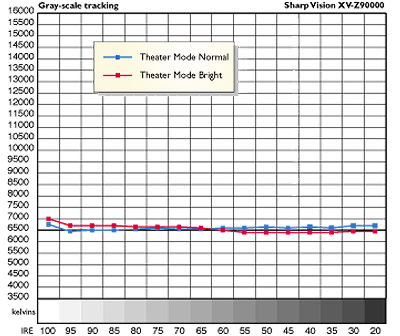Sharp XV-Z9000U 16:9 dlp projector Measurements

For logistical reasons, the Sharp DLP projector calibrated here was different from the samples MF and PM evaluated.
The SharpVision's service menu provides complete adjustment for the color temperature at both the high and low end of the brightness range. However, I was unable to obtain the access codes for the service menu in time to use it. This did not turn out to be a liability, however, as I was able to obtain an excellent result by setting the Color Temperature control to -3 and using only the red and blue (overall) level adjustments provided on the user menu. The results are shown in Fig.1. In both cases, the user-adjustable Gamma control was set on Standardthe setting that in my opinion produced the most natural-looking result. Note that I have plotted two curves here, one with the Theater Mode set on Normal, another with it set on bright. On my Stewart StudioTek 130 screen (16:9, 84" wide, 1.3 gain), Normal produced a peak brightness of 11ft-L and Bright 16.3ft-L. Unlike a CRT, a DLP does not bloom when pushed to high levels, but excessive output can result in white clipping; that is, there is a loss of differentiation in the brightest whites. Neither Normal nor Bright exhibited this problem at the light outputs indicated. I definitely preferred the Theater Mode in its Bright setting. If I had used a Grayhawk or similar screen with its lower gain, I suspect my preference for Bright would have been even more pronounced.
The contrast of a video display can be measured in any number of ways, often resulting in very different values. I measured the contrast of the SharpVision three different ways: full-on/full-off, 16-square checkerboard, and 100IRE window. Test patterns from the Video Essentials DVD were used in all cases. In full-on/full off, the flat field (full-screen) 100IRE (maximum brightness) output (VE, chapter 18-14) was compared with the full-screen black field resulting from an open input. The result was a contrast ratio of 663. In the checkerboard test (VE, chapter 17-28) each of the 16 squares was measured, the high and low values thrown out, and the resulting average high and low values compared. This resulted in a contrast measurement of 54. And in the 100IRE white window method, the output from a 100IRE window (VE, chapter 17-10 or 17-32) is compared with an averaged reading from the black border surrounding it. The latter method is my own, and in my opinion probably the most realistic method for simulating a display's performance with typical video material. It resulted in a contrast ratio of 159.
The projector's internal scaler recognizes 3:2 pulldown. I drove the projector alternately from a DVD source in both 480i and 480p, and while its performance was excellent in both modes, I marginally preferred the 480p. The main difference wasn't in artifacts; SharpVision's de-interlacing may not be state-of-the-art, but it worked fine on most good program material. But the progressive input appeared to be marginally crisper and more detailed. The difference, however, was subtle.
I did spend several hours watching DVD and high definition programming on the SharpVision, and was as impressed with it as were Michael and Pat on both types of material. As a longstanding member of the CRT Society, however, I did miss the richer image that CRTs deep blacks provide. At the same time, the projector's picture had a little less punch on scenes with middling brightness than I recall from the far more expensive Madrigal MP-9 CRT that had left my system only two weeks earlier. A Grayhawk or similar screenwhich I did not have on-handmay provide at least a partial improvement. High definition material was a bigger step up in quality from DVD than I normally expect, which was a surprise; the jury is still out as to why this might be.
I was able to make one interesting comparison of the SharpVision with the Madrigal MP-9, though both projectors were not on-site at the same time. I had measured the output brightness vs the input level on the Madrigal at each step of the gray scale (the gamma curve). I made similar measurements on the Sharp (gamma in Standard) and then normalized them so that the levels were within 0.33% of each other at both 30IRE and 100IRE. Comparing the adjusted readings showed that the Sharp had a little more light output at the dark end (35-45IRE) and a little less in the midrange (50-65IRE). The biggest differences were 7% more output from the Sharp at 35IRE and 5% less at 55IRE. These results could explain both the Sharp's slightly poorer blacks and the CRT's slightly greater punch (from more output in the mid-brightness range). I suspect that small changes in gamma are an underappreciated factor in the quality of a video display's imagevery possibly more important than small deviations in the gray scale.
One last note: In a poorly ventilated room, the Sharp emitted a slightly pungent odor (it was not "new paint smell," as the sample I tested had nearly 300 hours on its lamp timer). Neither MF nor PM commented on this, however. I mention it merely as an something you might want to test for if the projector is to be used in a small, closed space.TJN




























































